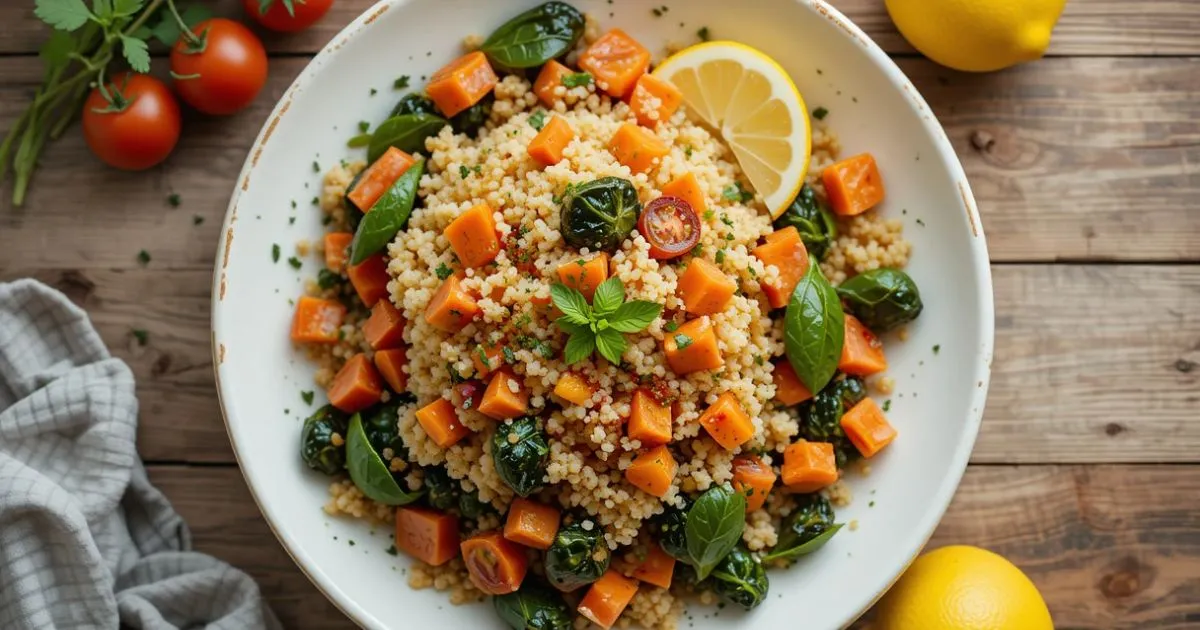carrot and spinach recipes with couscous and tomatoes
Table of Contents
Introduction: carrot and spinach recipes with couscous and tomatoes
Are you ready to embark on a flavor-packed adventure featuring sweet carrots, vibrant spinach, fluffy couscous, and juicy tomatoes? Think of this guide as your ticket to a delightfully delicious journey—no passport required! Whether you’re a seasoned home cook or a kitchen newbie looking to spice things up, get ready to discover how these humble ingredients can join forces in dishes that look just as good as they taste. Stick around, and we’ll reveal tips, tricks, and mouthwatering recipes that will have you wondering why you didn’t start experimenting with carrots and spinach in couscous ages ago!
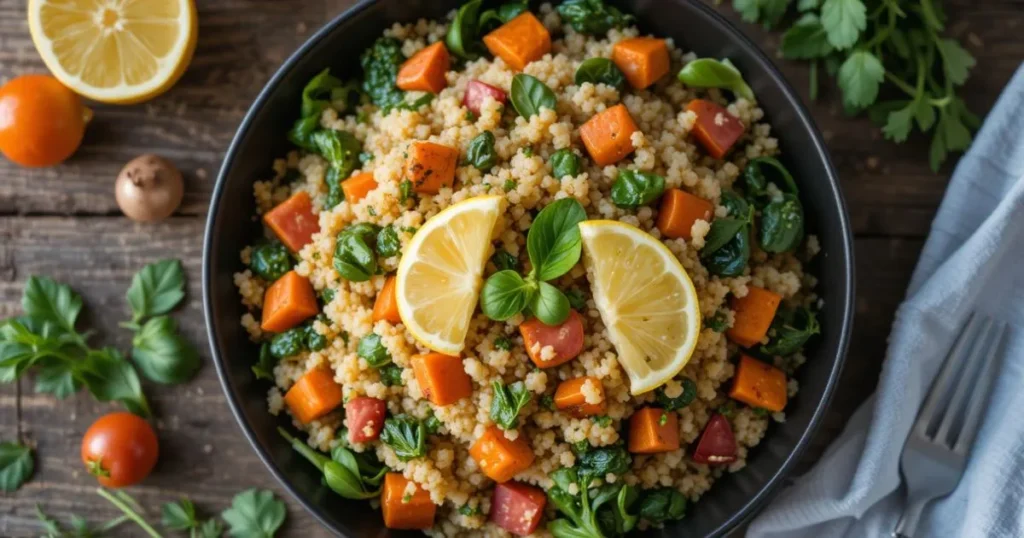
Essential Insights and Key Takeaways
Why Carrots, Spinach, and Couscous Make a Winning Trio
When these three superstars unite on your plate, magic happens. Here’s why:
- Texture Overload: The natural crunch of carrots meets the delicate leaves of spinach, all nestled in fluffy couscous.
- Flavor Fusion: Sweet carrots, earthy spinach, and subtle couscous balance each other, especially when paired with juicy tomatoes.
- Nutrient Powerhouse: You get a boatload of vitamins, minerals, and fiber in every single forkful.
A Brief History and Origins of Couscous
Couscous has been delighting taste buds for centuries (seriously, centuries!). It hails from North African cuisine and has traveled far and wide, finding its way into kitchens around the world. A few fun facts:
- Versatility: Whether used in salads or as a hearty dinner side, couscous adapts like a culinary chameleon.
- Cultural Staple: In many cultures, couscous symbolizes abundance and is often served at special occasions.
Top Nutritional Benefits
Carrots, spinach, tomatoes, and couscous are like the Avengers of the culinary world—individually awesome, but even better together. Here’s a quick snapshot of why they’re so fantastic:
- Carrots: High in beta-carotene (awesome for eye health) and antioxidants.
- Spinach: Loaded with iron, calcium, and essential vitamins.
- Tomatoes: Bursting with vitamin C and lycopene.
- Couscous: A great source of protein and selenium, offering a satisfying base for any meal.
Versatility in the Kitchen
Think of these ingredients as your blank canvas—only it’s a very tasty canvas that’s ready for some creative flair. They can easily transform into:
- Salads: A quick, refreshing option perfect for busy weeknights.
- Soups: Cozy bowls of goodness to warm you up on chilly days.
- Main Dishes: Hearty one-pot wonders brimming with flavor.
Gathering Your Ingredients and Finding Local Deals
Which Couscous to Choose?
Ready to delve into the couscous cosmos? Every variety adds its distinct charm:
- Moroccan Couscous: The smallest and fluffiest of the bunch. Perfect for quick cooking (as in, lightning-fast) and absorbing flavor in a flash.
- Israeli (Pearl) Couscous: Plump, chewy, and oh-so-satisfying. Think of these pearls as the “bubble tea” version of couscous—a fun texture you’ll want to bite into.
- Whole Wheat Couscous: A heartier, nuttier option that packs extra fiber. Great if you’re aiming for a healthier spin without sacrificing taste.
(Pro Tip: Don’t be afraid to mix and match—just keep cooking times in mind so everything finishes at the same delicious moment.)
Selecting Fresh Produce
When it comes to carrots, spinach, and tomatoes, freshness is your best friend:
- Carrots: Look for firm, brightly colored roots. If they come with greens attached, make sure those are fresh and vibrant, too!
- Spinach: Sniff around for bright green leaves—skip the wilted or yellow-ish ones.
- Tomatoes: Go for slightly firm tomatoes with a noticeable tomato-y aroma (yes, they do smell like summer when they’re ripe!).
(Fun Fact: If you see any questionable spots on your produce, imagine them saying “Pick me, pick me—just not from this angle!” and promptly move on to the next candidate.)
Locating Seasonal Bargains
Who doesn’t love a good deal? Here are some sleuth-like tactics to score the freshest finds without busting your budget:
- Farmers’ Markets: Early birds catch the best produce—and sometimes special discounts when vendors are near closing time.
- Community-Supported Agriculture (CSA): Sign up for weekly or bi-weekly produce boxes at a set price—guaranteed fresh and often cheaper in the long run.
- Local Grocery Sales: Keep an eye on flyers or apps for seasonal specials. You might discover unexpected price drops on carrots and tomatoes.
(Money-Saving Tip: Team up with a friend for bulk deals. Split the cost—and the carrots—if you can’t finish them all on your own.)
Step-by-Step Preparation Techniques
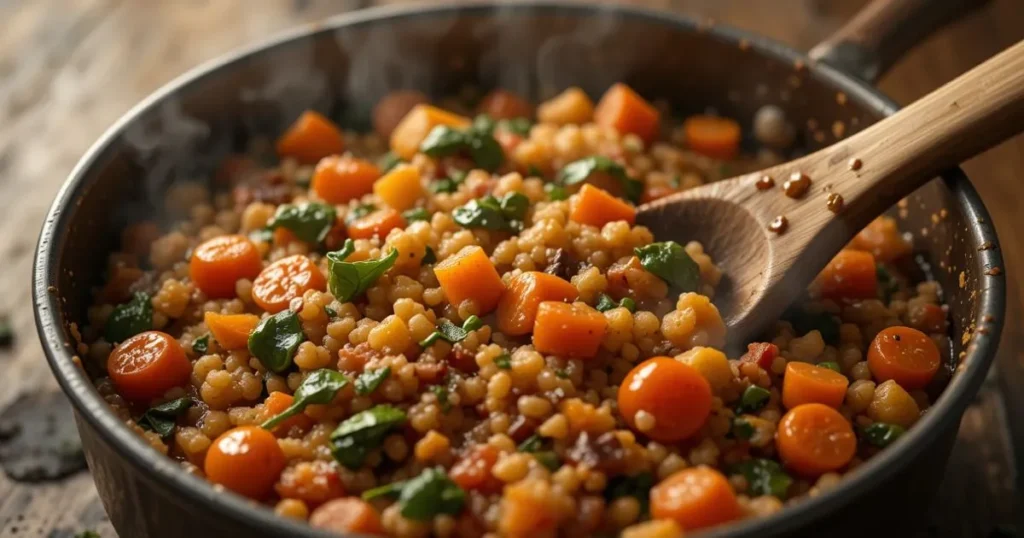
Perfectly Roasting Carrots
Nothing says “Yum!” like the rich, caramelized edges of flawlessly roasted carrots. It’s basically a spa day for your veggies—only instead of cucumber slices, we’re popping them in the oven. Here’s how to make it happen:
- Preheat & Prep: Crank up the oven to around 400°F (200°C). Slice carrots into uniform sizes so they roast evenly.
- Drizzle & Season: Coat with a splash of olive oil, a pinch of salt, and your favorite herbs or spices (paprika, cumin—go wild!).
- Roast to Perfection: Spread them out in a single layer and let them sizzle for about 20–25 minutes. Check for that golden-brown glow!
Incorporating Spinach Without Overcooking
Spinach is a delicate diva—treat it right, and it’ll dazzle you with its bright color and subtle flavor. Overdo it, and it turns into a sad, mushy mess. Here’s how to keep it shining:
- Timing Is Key: Add spinach in the final moments of cooking. A quick toss on medium heat is all it needs.
- Gentle Heat: If you’re adding it to a soup or stew, stir it in right before you take the pot off the burner.
- Flavor Boost: A tiny drizzle of lemon juice or a sprinkle of nutmeg can make spinach even more vibrant (and keep people guessing about your secret ingredient).
Cooking Couscous for Maximum Fluffiness
Say hello to your new best friend: fluffy couscous. It’s quick, versatile, and loves to soak up flavors like a culinary sponge. Achieving cloud-like couscous is easier than you think:
- Liquid Ratio: Generally, go for a 1:1 or 1:1.25 ratio of couscous to liquid (broth or water). Check the package for specifics.
- Cover & Steep: Once you’ve poured boiling liquid over the couscous, cover the pot and let it hang out for about 5 minutes.
- Fluff & Go: Gently fluff with a fork to separate the grains. Resist the temptation to over-stir—no one wants couscous clumps.
Infusing Tomato Flavors
Tomatoes can transform your dish from “meh” to “marvelous” in no time. Whether you use fresh, roasted, or canned varieties, they’ll add a burst of tangy sweetness:
- Fresh Tomatoes: Opt for ripe tomatoes for a burst of natural juiciness; remove seeds if you prefer a less watery texture.
- Roasted Tomatoes: Pop some tomato halves in the oven with olive oil and herbs. Bonus: they develop a rich, smoky taste that’s totally drool-worthy.
- Canned or Pureed: Great time-savers that still deliver big on flavor. Look for diced, crushed, or whole peeled tomatoes—and don’t forget to season to taste.
(Now that you’ve got the secret sauce on prep techniques, get ready for some next-level recipes where these stars truly shine!)
Delicious Recipe Variations
Zesty Couscous Salad with Carrots and Spinach
Meet your new lunchtime BFF: a salad so fresh and tangy, you’ll want to show it off at every potluck. Combine fluffy couscous, thinly sliced carrots, and a handful of crisp spinach leaves, then bring on the big flavors:
- Citrus Dressing: Whisk together freshly squeezed lemon or orange juice, a splash of olive oil, and a pinch of salt and pepper.
- Fresh Herbs: Add chopped mint or parsley for an extra zing.
- Crunch Factor: Toss in some diced cucumbers, bell peppers, or even toasted nuts (pine nuts = chef’s kiss).
Herb-Infused Couscous with Roasted Carrots and Spinach
Prepare for an herbal affair that’ll delight your taste buds. This aromatic dish combines couscous with roasted carrots, spinach, and a bouquet of fresh herbs:
- Herb Medley: Experiment with thyme, rosemary, oregano, or basil—let your herb garden instincts run wild.
- Roasty Goodness: Coat carrots with olive oil, salt, and a pinch of your chosen herbs before roasting for a flavor explosion.
- Finish with Spinach: Stir in spinach at the end so it retains that lovely green hue.
Tomato-Focused Couscous with Carrots and Spinach
Tomatoes take center stage in this robust and hearty dish that’s perfect for those who crave a tangy twist:
- Tomato Base: Simmer diced tomatoes (fresh or canned) with onions, garlic, and a hint of chili flakes.
- Carrots & Spinach: Add pre-roasted carrots for sweetness, then fold in spinach at the last minute.
- Couscous Soak-Up: Cook your couscous in this tomato-y goodness, letting each grain absorb that rich sauce.
Comforting Carrot, Spinach, and Couscous Soup
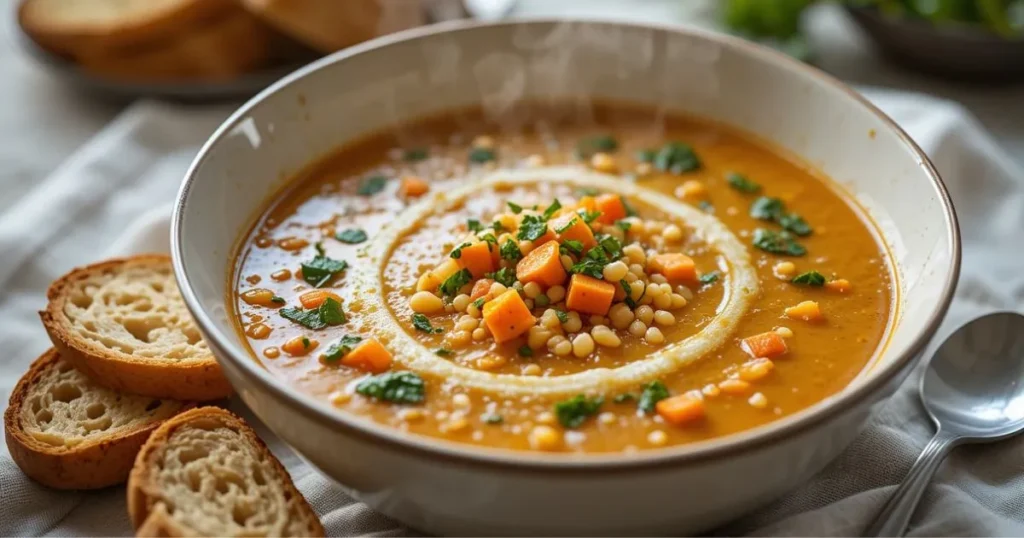
When you’re looking for a soul-soothing meal that practically hugs you from the inside, this soup is a must-try:
- Light Broth: Start with veggie or chicken stock, then toss in diced carrots, onions, and garlic.
- Simmer & Season: Let the flavors mingle, adding salt, pepper, and maybe a sprinkle of your go-to spice blend.
- Couscous & Spinach Finale: Stir in couscous a few minutes before serving. Just when you’re about to ladle it up, drop in a handful of spinach leaves.
Pilaf-Style and One-Pot Options
For those busy nights when doing extra dishes feels like climbing Mount Everest, a one-pot wonder is your hero:
- Aromatics First: Sauté onions, garlic, and spices in olive oil.
- Add Veggies & Couscous: Stir in carrots and spinach (plus any bonus veggies or protein you fancy). Then mix in couscous.
- Simmer & Serve: Pour in broth, bring everything to a simmer, cover, and let the magic happen—no fuss, all flavor.
Boosting Flavor and Taste
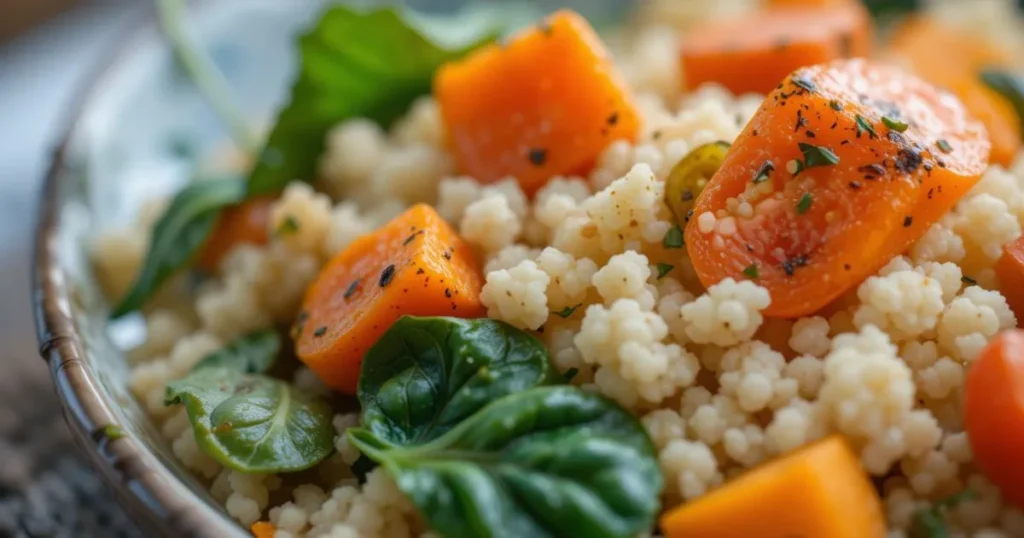
Choosing the Right Herbs and Spices
Selecting the best herbs and spices is like assembling your kitchen dream team. Mix and match for maximum flavor impact:
- Cumin & Coriander: An earthy duo that adds warmth and depth—perfect for cozy, comforting dishes.
- Paprika: Offers a mild smokiness (regular) or a fiery kick (smoked paprika).
- Fresh Herbs: Mint and parsley bring a burst of green magic—chop them up and toss them in right before serving so they stay vibrant.
(Pro Tip: Test out blends! A dash of paprika + a hint of cumin = a flavor power couple your taste buds won’t forget.)
Dressings, Sauces, and Garnishes
Sometimes the difference between “good” and “wow!” is a drizzle of the right sauce or a sprinkle of something crunchy. Consider these easy upgrades:
- Vinaigrettes: Whisk together olive oil, vinegar (red wine or balsamic), plus a spoonful of mustard or honey for a tangy, sweet punch.
- Creamy Sauces: Stir yogurt or sour cream with lemon juice, garlic powder, and herbs for a lush finish.
- Crunch Factor: Top it all off with toasted nuts, seeds, or crispy fried onions—because texture = fun.
Balancing Seasonings
Finding that perfect flavor harmony is equal parts art and science. Here’s how to hit all the right notes:
- Salt: Enhances natural tastes—sprinkle carefully to avoid salt overload.
- Pepper: A subtle kick that keeps flavors from falling flat.
- Acidity: A splash of lemon juice or vinegar can bring bright, zesty contrast to a savory dish.
Nutrition Facts and Serving Suggestions
Caloric and Macronutrient Breakdown
Curious about what’s in your bowl of carrot, spinach, and couscous goodness? While exact counts vary based on your add-ins (and how generous you are with those drizzles of olive oil), here’s an estimate of the nutritional breakdown for a single serving (approximately 1 cup):
- Calories: Typically between 300–400 calories per serving, depending on portion sizes, toppings, and sauces.
- Protein: Couscous and vegetables provide a small amount of protein (around 7–10 grams). For an extra protein boost, consider adding chickpeas, grilled chicken, or tofu.
- Carbohydrates: Carrots, couscous, and tomatoes supply carbohydrates, including complex carbs from couscous and natural sugars from vegetables, to help sustain energy.
- Fiber: Spinach, carrots, and whole wheat couscous contribute 4–6 grams of fiber per serving, supporting digestion and helping you stay fuller longer.
(These values can vary based on portion sizes, extra ingredients, and how generous you are with dressings or toppings.)
Disclaimer:
“Nutritional values are estimates and may vary based on portion sizes, preparation methods, and additional ingredients. This content is for informational purposes only and is not a substitute for professional dietary advice.”
Serving Sizes and Meal Prepping
Let’s talk practical. Unless your middle name is “Bottomless Pit,” portion control and planning ahead can save time, money, and a few extra notches on your belt:
- Serving Sizes: A good rule of thumb is about 1 cup of cooked couscous per person, plus a fistful of veggies (or more if you love that carrot crunch).
- Meal Prepping:
- Make Big Batches: Cook extra couscous and roasted carrots at once. They keep well in the fridge for up to 3–4 days.
- Store Separately: Keep spinach or dressings in separate containers to avoid soggy everything.
- Quick Reheats: A quick microwave zap or a warm skillet refresh can bring leftover
- couscous dishes back to life.
Frequently Asked Questions (FAQ)
What Are Some Quick Carrot and Spinach Recipes with Couscous?
You can create a simple salad by tossing couscous with lightly sautéed carrots and spinach, then adding a vinaigrette. For a heartier option, try a one-pot couscous dish with veggies and a few spices. Both approaches typically take under 30 minutes to prepare.
How Can I Incorporate Tomatoes into These Dishes?
Use fresh tomatoes for a bright, raw flavor, or roast them to develop sweetness and depth. Canned tomatoes also work well in sauces or soups for a richer taste. Incorporating tomatoes toward the end of cooking helps preserve their texture.
Which Type of Couscous Is Best for These Recipes?
Moroccan couscous is light and cooks quickly, making it ideal for salads. Israeli (pearl) couscous offers a chewy texture that pairs well with roasted vegetables. Whole wheat couscous adds a heartier, nuttier flavor and extra fiber.
How Do I Keep My Couscous Fluffy and Light?
Use the correct liquid-to-couscous ratio (about 1:1 or 1.25:1). After pouring in the hot liquid, cover and let the couscous sit for five minutes before fluffing gently with a fork. Avoid stirring too vigorously to prevent clumping.
Which Herbs and Spices Pair Well with Carrot and Spinach?
Cumin, coriander, and paprika offer warm, earthy notes that complement carrots and spinach. For fresh herbs, mint and parsley brighten the overall flavor. You can also experiment with thyme or rosemary for a more aromatic profile.
Can I Make These Dishes Ahead of Time for Meal Prep?
Absolutely—couscous dishes often taste even better after flavors meld in the fridge. Store components like cooked couscous and roasted veggies separately from sauces or dressings to maintain texture. Reheat gently on the stovetop or in a microwave to preserve quality.
Are Leftovers Freezable or Best Consumed Fresh?
Most couscous-based dishes can be frozen, but you may notice a slight change in texture upon thawing. If possible, consume within a few days for the best flavor and consistency. When freezing, store in airtight containers and reheat slowly to retain moisture.
Conclusion
Congratulations—you’ve officially conquered the world of carrots, spinach, couscous, and tomatoes! From quick salads to hearty soups, you now have a diverse lineup of dishes that are as delightful to eat as they are to make. Whether you’re roasting, simmering, or simply tossing ingredients together, this flavorful foursome will keep your meals vibrant, nutritious, and downright delicious. Happy cooking and bon appétit!

